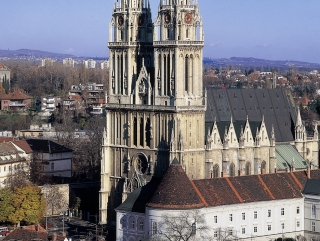ZAGREB CATHEDRAL
Croatia's largest religious structure and one of the most valuable monuments of Croatian cultural heritage.
Croatia's largest religious structure and one of the most valuable monuments of Croatian cultural heritage.
Construction of the cathedral began after the founding of the Zagreb diocese 1094th year. The cathedral was completed and consecrated in 1217. Through the years, many times has been damaged and restored. The worst is perished in the Great Earthquake of 1880. Then was followed a thorough renovation of the cathedral in neogothic style, according to the designs of the Viennese builder Schmidt, and construction was led by Hermann Bollé. It was finished in 1906th year and then it acquired its present form.
The cathedral is 77 meters long and 48.2 meters wide. The towers are 108 feet high, and the inner area is 1617 m2. The cathedral can accommodate more than 5,000 people. The cathedral is a symbol of Zagreb and monument of faith and culture of the Croatian people.
Zagreb Cathedral is the most stylish architecture monument of church architecture in gothic style south of the Alps. Plans, the buildings of the sanctuary, with slender cross-ribbed arches within three polygonal apses open a narrow window, similar to the approaches of France (the town of Troyes), elaboration subsequently raised, height equivalent liner, corresponding to structural arrangements of modern German architecture, and sculpture reflects the imaginative touch with the Czech schools. All this speaks not only of the early penetration of the Gothic in the north and the internationalization of Croatian art, but also the then importance of the Zagreb diocese and the reputation and power of its bishops. From the very beginning of the cathedral was dedicated to the Blessed Virgin Mary, and Assumption (Assumption folk). St.. Stephen, king of Hungary, was, though, pointed out in the first place, only the second patron.

